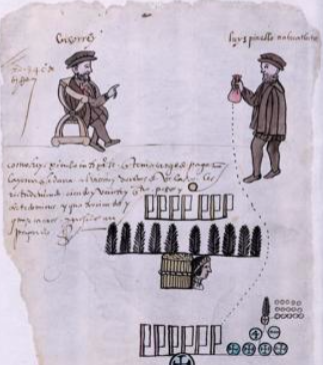nahuatlato (Osu10v)
This detail of an interpreter (nahuatlato) is found on folio 10 verso (or image 23) of the Codex Osuna. It is included here for the purpose of making comparisons with Nahuatl hieroglyphs. It shows what is likely a Spaniard, given his beard, his hat, and his clothing, which is much like the viceroy in the scene (see the contextualizing image). Also, his name is Luis Pinelo (as explained in the Spanish-language gloss, but spelled Pinello in the Nahuatl-language gloss). He is facing toward the viewer’s left and facing the viceroy. He is holding up a red cloth sack in his right hand, and there is a dotted line connecting this bag from what appear to be the pesos under dispute in the broader scene on this folio. The Nahuas had to supply a large quantity of grass (“yerva,” i.e., hierba, given in the Spanish text, and [...]tlacualli mentioned in the Nahuatl text) to the colonizers, presumably for feeding their horses, and they were complaining about a debt they were owed. The debt involved 124 pesos, 7 tomines, and 415 cacao beans for the 4,141 loads of grasses that they had provided.
Stephanie Wood
Our Online Nahuatl Dictionary includes examples of several nahuatlatoque from the sixteenth and seventeenth centuries. Complaints were sometimes made about interpreters who were cheating the Nahuas. Cacao beans, a pre-contact type of currency, were still valid well into the Spanish colonial period, often in combination with tomines (pieces of eight, or eighths of pesos). For Nahuas, tomines, as the smaller-denomination coins, were more prevalent, and the term could come to mean “coins” or “money.” A reference to “cempohualli pesos tomines” would mean that a payment the equivalent of 20 pesos was made all in tomines (160 coins), as seen in 1547 in Tlaxcala (see one of the OND entries for tomin).
Stephanie Wood
1551–1565
Jeff Haskett-Wood
interpretes, interpretar, traducir, Nahuatl, español, oficios, alcaldes, cabildos indígenas, virreyes, pesos, cacao beans, cacahuatl, tomines
nahuatlato, interpreter who knows Spanish and Nahuatl, https://nahuatl.wired-humanities.org/content/nahuatlato
alcalde, a magistrate on the Indigenous town council, https://nahuatl.wired-humanities.org/content/alcalde
el nahuatlato
Stephanie Wood
Library of Congress Online Catalog and the World Digital Library, Osuna Codex, or Painting of the Governor, Mayors, and Rulers of Mexico (Pintura del Gobernador, Alcaldes y Regidores de México), https://www.loc.gov/resource/gdcwdl.wdl_07324/. The original is located in the Biblioteca Nacional de España.
"The Library of Congress is unaware of any copyright or other restrictions in the World Digital Library Collection. Absent any such restrictions, these materials are free to use and reuse." But please cite the Biblioteca Nacional de España and this Visual Lexicon of Aztec Hieroglyphs if you use any of these images here or refer to the content on this page, providing the URL.



